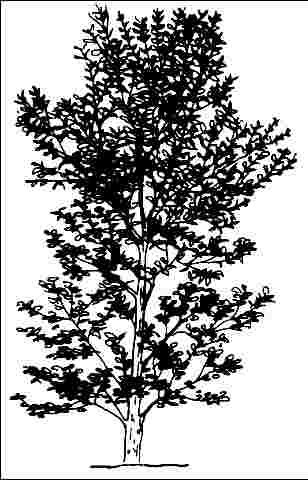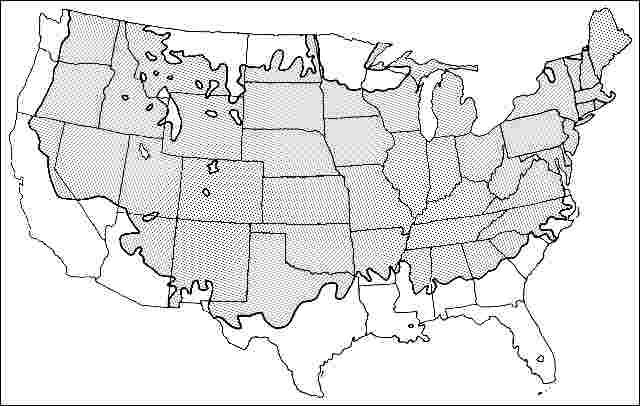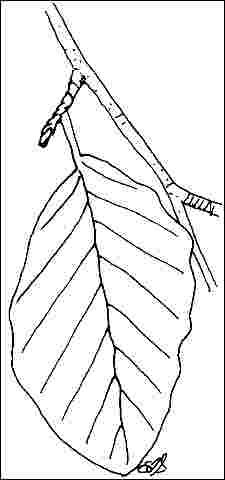Introduction
European Beech grows into a wide oval, 80 to 100 feet tall and spreads 50 to 70 feet. Branches normally sweep the ground in a graceful fashion. The tree grows slowly, is hard to transplant and prefers a sunny location and a moist, light soil. Though not a street tree, the tree makes one of the finest specimens of all those available in North America for large scale landscapes. European Beech is somewhat tolerant of heat and dry soil, but it is best to locate it where it would receive adequate moisture. The cultivars `Pendula' and `Fastigiata' are more available than the species and very attractive.

General Information
Scientific name: Fagus sylvatica
Pronunciation: FAY-gus sill-VAT-ih-kuh
Common name(s): European Beech
Family: Fagaceae
USDA hardiness zones: 4A through 7B (Fig. 2)
Origin: not native to North America
Invasive potential: little invasive potential
Uses: hedge; specimen; shade
Availability: somewhat available, may have to go out of the region to find the tree

Description
Height: 50 to 75 feet
Spread: 40 to 60 feet
Crown uniformity: symmetrical
Crown shape: oval
Crown density: dense
Growth rate: moderate
Texture: medium
Foliage
Leaf arrangement: alternate (Fig. 3)
Leaf type: simple
Leaf margin: undulate, entire
Leaf shape: ovate, elliptic (oval)
Leaf venation: pinnate
Leaf type and persistence: deciduous
Leaf blade length: 2 to 4 inches
Leaf color: green
Fall color: copper
Fall characteristic: showy

Flower
Flower color: unknown
Flower characteristics: not showy
Fruit
Fruit shape: oval
Fruit length: .5 to 1 inch
Fruit covering: dry or hard
Fruit color: brown
Fruit characteristics: attracts birds; not showy; fruit/leaves not a litter problem
Trunk and Branches
Trunk/bark/branches: branches droop; very showy; typically one trunk; thorns
Pruning requirement: little required
Breakage: resistant
Current year twig color: brown, gray
Current year twig thickness: thin
Wood specific gravity: unknown
Culture
Light requirement: full sun, partial sun or partial shade
Soil tolerances: clay; sand; loam; acidic; slightly alkaline; well-drained
Drought tolerance: moderate
Aerosol salt tolerance: low
Other
Roots: can form large surface roots
Winter interest: yes
Outstanding tree: no
Ozone sensitivity: tolerant
Verticillium wilt susceptibility: resistant
Pest resistance: resistant to pests/diseases
Use and Management
European Beech has given rise to many cultivars: `Albo-variegata' - leaves margined white; `Asplenifolia' - cut leaves; `Atropunica' - leaves purple; `Cochleata' - smaller, spoon-shaped leaves; `Cuprea' - leaves copper colored; `Dawycki' - upright growth habit; `Fastigiata' - upright growth habit; `Laciniata' - leaves cut, wider more regularly-shaped than `Asplenifolia'; `Macrophylla' - larger leaves; `Miltonensis' - leader erect, main branches horizontal, side branches pendulous; `Pendula' - weeping habit; `Purpurea Pendula' - weeping with purple leaves; `Quercifolia' - slow growing, leaves oak-like; `Riversii' - young foliage reddish then purple; `Rohanii' - similar to `Laciniata'; `Roseo-marginata' - purple leaves with light pink border, grow in shade to prevent leaf burn, not easily grown; `Rotundifolia' - leaves round; `Spaethiana' - leaves purple; `Tortuosa' - low, spreading, umbrella-like; `Tricolor' - leaves green and white with pink margins; `Zlatia' - leaves golden in spring.
Pests
Usually none are serious. Aphid colonies on the lower branches can be dislodged with a strong stream of water from the garden hose. Colonies are often disposed of by predatory insects.
Borers such as flat-headed appletree borer or two-lined chestnut borer bore into trees weakened by some stress. Prevent the insect infestations by keeping trees healthy with regular fertilization and irrigation in dry weather.
Regular inspections of the trunk and branches are suggested for early detection of scales. Horticultural oil sprays will help control scales.
Certain caterpillars can be controlled with sprays of Bacillus thuringiensis .
Diseases
Usually none are serious provided soil is loose and is well-drained.
Several fungi cause leaf spots but are generally not serious to warrant chemical control.
Powdery mildew causes a white coating on the leaves. The disease is most common late in the season.
Bleeding canker forms cankers from which a brownish liquid oozes. Crown symptoms include leaves of smaller size and lighter green color than normal. In severe cases the leaves wilt and the branches die. Avoid feeding with high nitrogen fertilizers as it seems to worsen the condition of infected trees.
Beech bark disease occurs when the feeding site of woolly Beech scale is invaded by a fungus. The fungus kills the bark and in the process, the insects. There are no satisfactory controls for the fungus. Control the disease by controlling the scale with a horticultural oil.
Cankers infect, girdle, and kill branches. Prune out the infected branches.
During periods of high temperatures and low rainfall Beech leaves may scorch. Make sure trees are adequately watered.